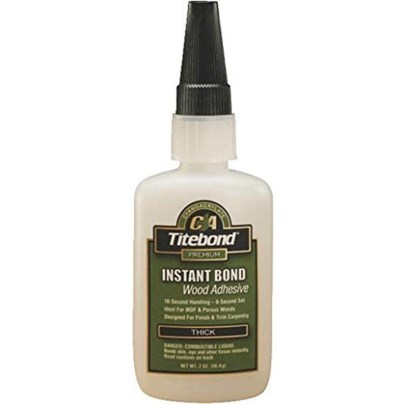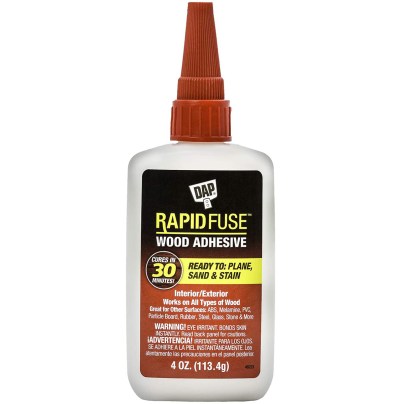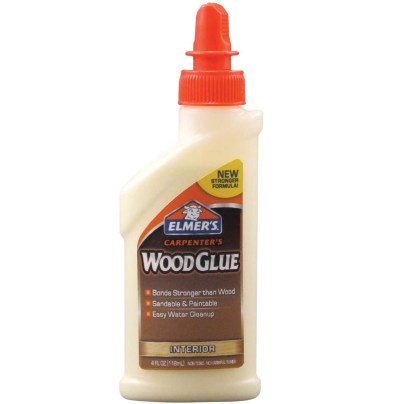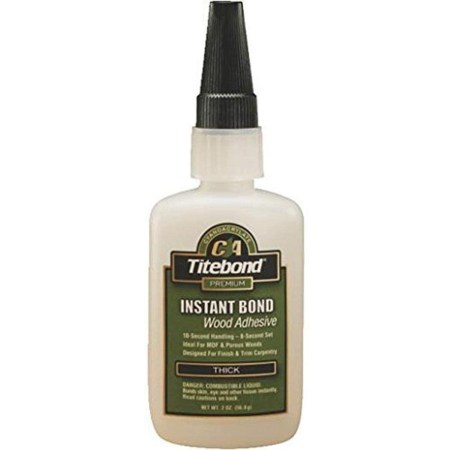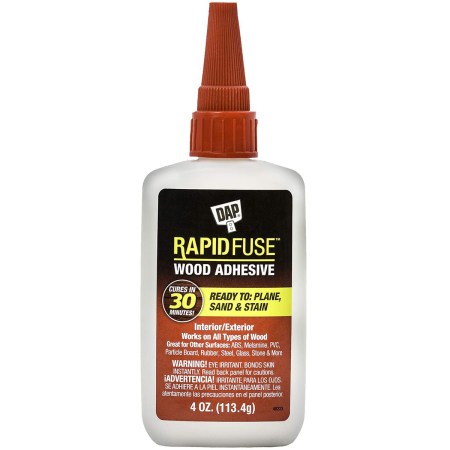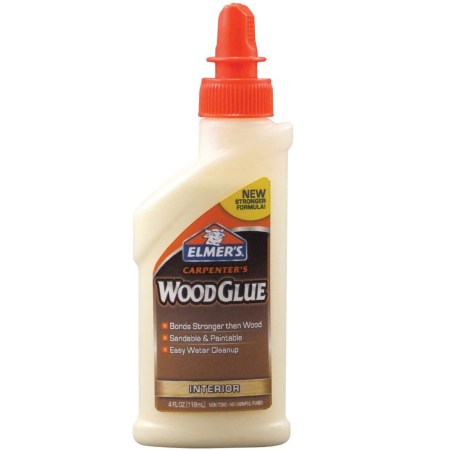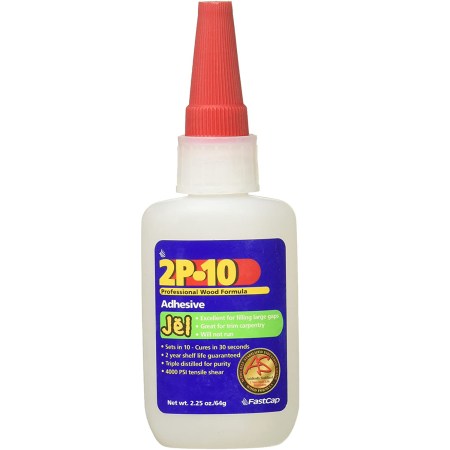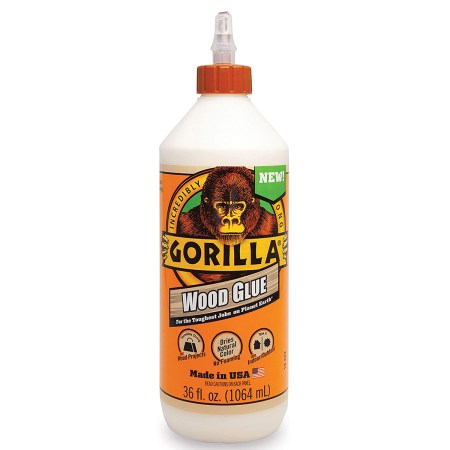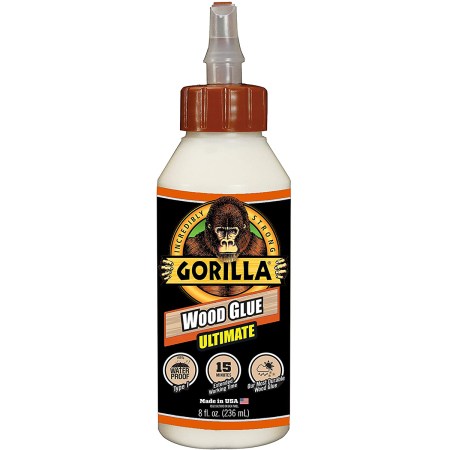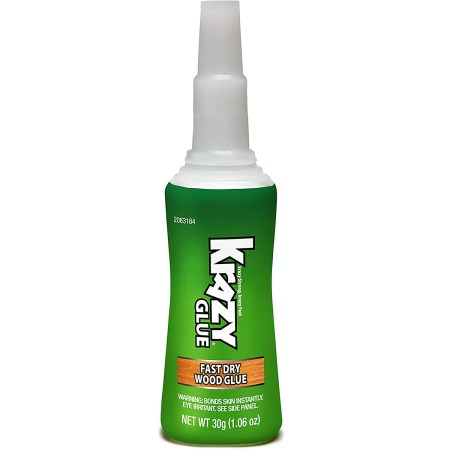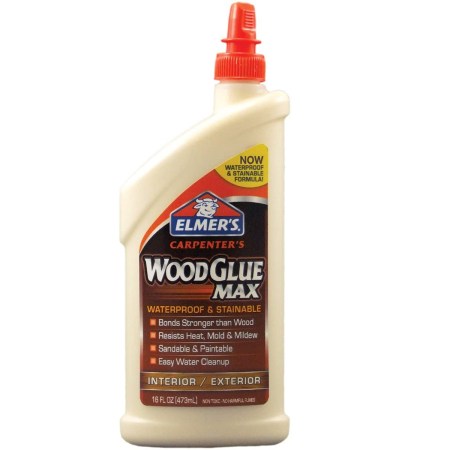We may earn revenue from the products available on this page and participate in affiliate programs. Learn More ›
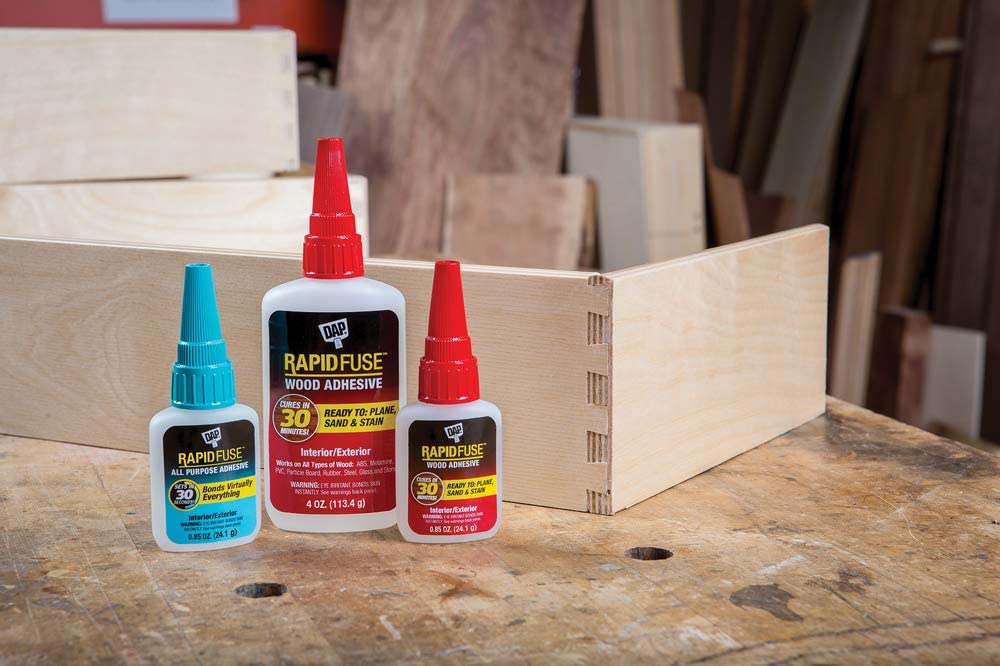
If you’re tackling woodworking projects using medium-density fiberboard (MDF), it doesn’t take long to realize the differences between MDF and plywood or typical wood. MDF is a combination of sawdust, shavings, resin, and waxes heated and compressed to form uniform, even sheets without grain or knots. It’s incredibly stable, but also very dense.
When it comes to joinery, MDF requires a strong glue that can penetrate the MDF surface to create a strong bond. But with so many wood glues on the market, which is the best glue for MDF? Keep reading to find out.
- BEST OVERALL: Titebond Instant Bond Wood Adhesive
- RUNNER-UP: DAP 00157 4 oz Rapid Fuse Fast Curing Wood Adhesive
- BEST BANG FOR THE BUCK: Elmer’s Products, Inc E7000 Carpenters Wood Glue
- UPGRADE PICK: FastCap 80070 2P-10 Professional 2 Ounce Jel Adhesive
- BEST LARGE SIZE: Gorilla 6206005 Wood Glue, 36 ounce Bottle
- BEST BOND: Gorilla Ultimate Waterproof Wood Glue
- BEST FAST-DRY: Krazy Glue, Fast Dry Wood Glue
- ALSO CONSIDER: Elmer’s E7310 Carpenter’s Wood Glue Max
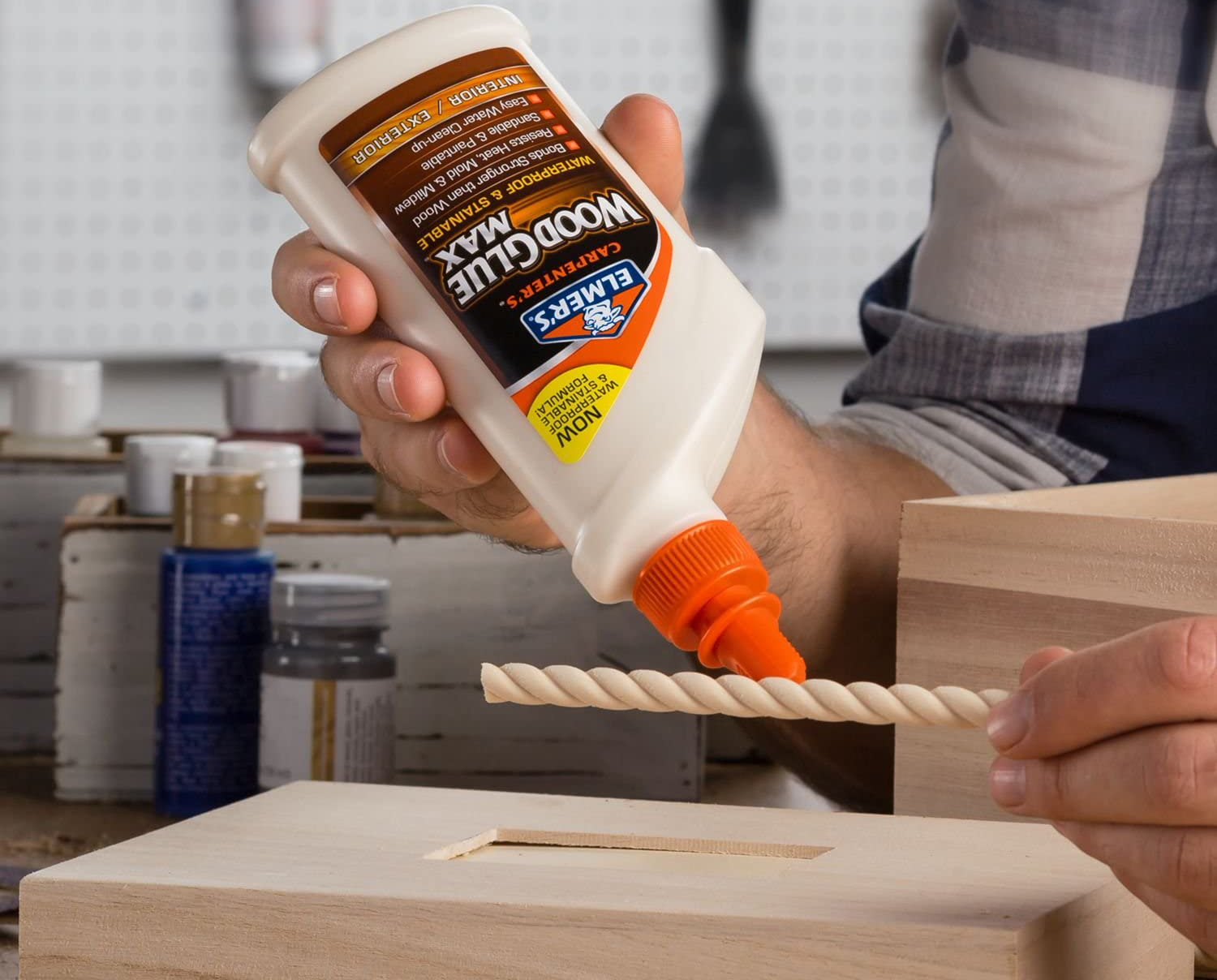
What to Consider When Choosing the Best Glue for MDF
MDF is incredibly easy to work with. It mills nicely, is incredibly easy on saw blades and drill bits, and paints nicer than almost any other product. But not just any wood glue will work with MDF. The following sections will outline some of the most important considerations to keep in mind when shopping for the best glue for MDF.
Types of MDF Glue
It probably comes as no surprise that there are several types of wood glue available. One look at the adhesive aisle in your local home store easily yields around 50 choices. Here are the basic types of the best glues for MDF:
- PVA glues contain polyvinyl acetates emulsified in water. They’re usually white or yellow, and these glues set quickly, but typically require 24 hours to fully cure.
- Plastic resin glues are just as they sound: a combination of plastic and resin. They typically require mixing, but they form a rigid plastic-like bond.
- Epoxies contain two parts: a resin and a hardener. They form very strong bonds, but the amount of time it takes them to cure can vary from a few minutes to 24 hours.
Application and Adhesion Strength
How you apply the best glue for MDF might be a factor in choosing a product. PVA glues are very safe and easy to clean. Users can dribble a few passes of glue across the surfaces before affixing the MDF together. A brush or a finger can also be used to spread the glue. For epoxy or plastic resin-based glues, users should avoid contact with their skin, so squeeze bottles and brushes are best.
The resulting bonds need to be durable, as MDF can be very heavy. Most PVA wood glues, plastic resins, and epoxies will do an excellent job of adhering MDF to MDF or even MDF to wood. But when it comes to adhering MDF to another surface (such as drywall), an all-purpose epoxy or plastic resin is the best way to go.
As far as strength and durability are concerned, epoxies and plastic resins generally create the strongest bonds. However, all glues create bonds that are stronger than the MDF itself, which means the integrity of the joint really comes down to the integrity of the fiberboard.
Cure and Assembly Time
All glues work on their own schedule. There are fast-dry glues that will bond right away and then slower-drying glues that allow the user plenty of working time for assembling several joints at once. Some woodworkers using MDF actually choose a combination of both, benefiting from a quick hold during assembly and a longer-lasting hold from a glue that dries more slowly.
It’s important to understand that setting and curing are two different things. Many types of glue will set within a few minutes; this is the initial bond between the surfaces that holds them in place. Superglue-type glues can set in seconds, while others typically take longer. However, it can take another 24 hours for many types of glue to fully cure, which is when the glue reaches its strongest hold.
Easy to Clean
Project assembly can be a messy and hectic time. Between the gluing, screwing, clamping, and doweling, there’s bound to be some excess glue. And some glues are much easier to clean than others.
PVA glue is incredibly easy to clean. PVA glue that hasn’t set yet is easy to remove with a damp paper towel or a card scraper.
For plastic resin and epoxy, paint thinner or acetone are sometimes the only way to remove excess glue, and both can quickly damage finished surfaces. When using these glues, it’s best to tape off anywhere excess glue might run before gluing and assembling.
Our Top Picks
Now armed with ample background information on the best glue for MDF, shopping for one of these products should be less complicated. To help streamline the process, the following list consists of some of the best products on the market for gluing MDF, and there is an option for almost any application.
Best Overall
Titebond Instant Bond Wood Adhesive
See ItWhen time and strength are both of the essence, Titebond’s Instant Bond Wood Adhesive Thick formula might be the product of choice. This plastic resin glue comes in a thick formula that’s especially helpful for MDF and other porous woods.
This glue features a 10-second handling time and an additional 8 seconds before the initial set. The initial cure occurs in 30 seconds, while the full cure takes 8 hours—much less than many other MDF glues. The dried glue is clear and unaffected by applied finishes. The bond is also impact-resistant and stronger than wood or MDF. Acetone is required for removing excess glue, so it’s important to be as careful as possible.
Runner-up
DAP 00157 4 oz Rapid Fuse Fast Curing Wood Adhesive
See ItWhether it’s for project assembly or quick repairs, DAP’s Rapid Fuse Fast Curing Wood Adhesive deserves a look. This plastic resin glue sets in just 30 seconds and cures in 30 minutes, at which point it’s ready for sanding, planing, or painting. And while it sets quickly, it remains workable for up to 3 minutes after gluing.
This 4-ounce bottle of glue works on MDF as well as other materials like wood, ABS plastic, melamine, particleboard, rubber, steel, PVC, glass, and stone. The bond that this MDF glue creates is stronger than MDF and it dries to a clear finish. And though this glue does require acetone to clean, its non-drip formula helps keep messes to a minimum.
Best Bang for the Buck
Elmer's Products, Inc E7000 Carpenters Wood Glue
See ItSometimes there’s nothing wrong with using a tried-and-true, old-school option like Elmer’s Products Carpenters Wood Glue for gluing MDF. This PVA wood glue will create strong bonds between wood-based products like MDF, and it’s one of the easiest products to use.
Elmer’s Wood Glue features a 20- to 30-minute clamp time, allowing users to reposition and assemble several joints at once. This also creates plenty of time to clean up glue that oozes out of the joints (which requires just a wet paper towel or a scraper). A full cure takes 24 hours, at which point the bond will be stronger than wood.
Upgrade Pick
FastCap 80070 2P-10 Professional 2 Ounce Jel Adhesive
See ItWhen it comes to fast, strong bonds, a premium product like FastCap’s Professional Jel Wood Adhesive might be worth the investment. While this bottle only contains 2 ounces of MDF glue, its performance speaks for itself.
When using FastCap Jel, users will have 2 to 4 seconds to assemble their pieces before the bond begins. At that point, they’ll have 10 seconds before the glue sets and then 30 seconds before it cures. The final cure takes just 5 minutes, at which point FastCap dries clear and forms a very strong bond. While the no-drip formula isn’t likely to run, any excess glue will require acetone for cleanup.
Best Large Size
Gorilla 6206005 Wood Glue, 36 ounce Bottle
See ItWhether it’s a professional cabinet shop or a hobby garage setup, there can never be enough glue. With Gorilla’s 36-ounce bottle, woodworkers aren’t likely to run out of glue in the middle of a project.
This PVA glue creates strong bonds between natural wood composites like MDF, hardwoods, and softwoods. During the initial clamping, this product takes 20 to 30 minutes to set before the clamps can come off. After that, it takes 24 hours for this glue to fully cure. Users can wipe away any excess glue that squeezes out during the assembly process. However, the cured glue dries to a natural color and consistency.
Best Bond
Gorilla Ultimate Waterproof Wood Glue
See ItGorilla Glue’s Ultimate Waterproof Wood Glue is worth a look for anyone searching for the strongest possible bond on their MDF projects. This PVA glue develops a strong, waterproof bond between wood surfaces, including MDF, hardwoods, and softwoods. The bond will also resist damage from water, the sun, and extreme temperatures.
This PVA glue features a clamping time of 20 to 30 minutes, allowing users to square up and assemble several joints at one time. Any glue that squeezes from the joint at this stage can be removed with a bit of water and a paper towel or sponge. Total cure takes 24 hours, which results in a natural color that can be sanded and painted, which is important for MDF projects.
Best Fast-Dry
Krazy Glue, Fast Dry Wood Glue
See ItMDF projects and repairs don’t have to take all day with Krazy Glue’s Fast Dry Wood Glue. This product features a maximum set time of 6 minutes, allowing users to get back to work right away without a long, drawn-out clamp time.
This plastic resin glue features Krazy Glue’s formula designed specifically for wood. It works on all species of wood, as well as MDF, creating fast bonds for quick repairs. It’s an excellent complement for a thicker PVA wood glue, as the initial bond can handle the joint while the PVA glue dries to a stronger bond. Since it is a plastic resin, it does require acetone to clean any excess glue.
Also Consider
Elmer's E7310 Carpenter's Wood Glue Max
See ItWith Elmer’s Carpenter’s Wood Glue Max formula, woodworkers, cabinetmakers, and carpenters can feel confident about the bonds and joints in their MDF projects. This PVA glue bonds all types of wood, and the resulting bond is heat, mold, and mildew resistant, as well as waterproof (though please note, MDF is not waterproof).
Using this Elmer’s formula is as straightforward as using its other products. Simply apply the glue liberally on both sides of the joint and clamp the assembled joint for up to 30 minutes while it sets. Users can wipe away excess glue with a damp sponge or paper towel. After setting, this glue does require 24 hours to fully cure, but it dries to a natural color that users can sand, stain, or paint without issue.
FAQs About Glue for MDF
With all of the background on the best glue for MDF, there are bound to be some additional questions hanging around. The following section aims to answer those queries, as it’s a collection of some of the most frequently asked questions about glue for MDF.
Q. Do I need to prepare the surface before gluing?
MDF creates a lot of dust, so it’s a good idea to wipe the area clean with a slightly damp towel before gluing the joint.
Q. How do I glue MDF boards together?
Gluing MDF boards together is straightforward. Simply apply the glue to both boards at the point you wish to join them and clamp them together. In most cases, it’s also a good idea to pre-drill a few holes and screw the boards together before they dry.
Q. Why won’t my MDF glue stick to the wood?
More than likely, the issue is that the surface is dusty. Simply wipe it clean with a damp towel and it will most likely adhere well.
Q. Can MDF glue be used to attach my board to a wall?
Yes, but there are a few things to consider. MDF will soak up a lot of the glue, so you have to apply it liberally. Also, mechanical fasteners such as finish nails or screws are a necessary addition since MDF is so heavy.
